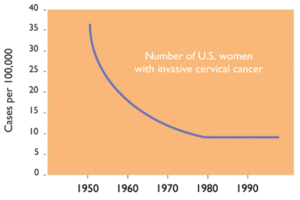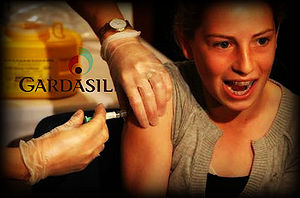Public Health Measures Against HPV
Introduction
HPV (human papilomavirus) is the most common sexually transmitted virus in America. There are approximately 6 million new cases of genital HPV every year in the United States. 74% of these cases occur in girls ages 15-24 ( The Facts). The Center for Disease Control estimated that 80% of women will become infected with genital HPV at some point in their life.
There are over a 100 different strains of HPV, but only 30-40 can be transmitted through sexual intercourse (HPV Types). Thus, one can get infected with HPV without actually having sex. Because of its prevalence, it is fortunate that most cases of HPV actually go away on their own. They cause the infected person little to no pain. Sometimes the infection even goes unnoticed. However, scientists have identified that there are four strains of HPV, which have serious effects and cannot be left untreated. Types 6 and 11 of HPV cause genital warts. Types 16 and 18 of HPV cause cervical cancer.
To upload an image: Use "Upload File" (in margin at left)
To make the image appear, you need to embed image insertion code (see sample at right). The insertion code consists of:
Double brackets: [[
Filename: PHIL_1181_lores.jpg
Thumbnail status: |thumb|
Pixel size: |300px|
Placement on page: |right|
Legend/credit: Electron micrograph of the Ebola Zaire virus. This was the first photo ever taken of the virus, on 10/13/1976. By Dr. F.A. Murphy, now at U.C. Davis, then at the CDC.
Closed double brackets: ]]
Other examples:
Bold
Italic
Subscript: H2O
Superscript: Fe3+
The Different Strains of HPV
There are over 100 different types of HPV virus, however, only 30-40 of those types are genital types (HPV Types). Scientists have divided these types up based on the potential effects of the virus. Some strains have been identified as more likely to cause genital warts. Others have been identified as likely to cause cervical cancer. 90% of people infected with types 6 and 11 will develop genital warts. These types are known as low-risk strains because they have a noticeable effect, however it is easily treated. There are approximately 1 million new cases of genital warts discovered in America every year (The Facts). Aside from the actual growths, there are other symptoms that are associated with genital warts: abnormal vaginal bleeding (especially after intercourse), increased vaginal discharge, itching and increased dampness in areas of the growths (Genital Warts). Genital warts must be treated by a doctor and can remerge after being treated (The Facts).
Cervical cancer is not genetic so it is unlike many other cancers. People get cervical cancer from certain stains of HPV: types 16 and 18. 70% of people infected with types 16 and 18 of HPV will get cervical cancer. The strains that are more likely to cause cervical cancer are known as high risk strains for the obvious reason that there is a high risk associated with that specific infection: cancer is very hard to cure. In 2008 alone, 11,070 women were diagnosed with cervical cancer (The Facts). The majority of women diagnosed with cervical cancer are between the ages of 35 and 55. However many of those women were most likely infected with one of these two types of HPV in their late teens or twenties. For women of all ages, HPV is a serious issue (Cervical Cancer). The symptoms of cervical cancer are similar to other illnesses so it is important that anyone experiencing these symptoms consult their doctor. These symptoms include abnormal vaginal bleeding, unusually heavy discharge, pain during urination, and pain in the pelvis. Cervical cancer can take a long time to develop but can also develop very quickly. The pre-cancerous cells in the cervix can also spread to other parts of the body, especially in the vagina, and cause other types of cancer (The Facts).
The Vaccine and Other Public Health Measures
Because sexually active women have such a high chance of contracting any type of HPV and certain types have been shown to cause genital warts and cervical cancer, there is a prominent public health movement to try to help prevent women from getting HPV and thus, prevent women from getting cervical cancer. All women are strongly encouraged to get tested regularly. The Pap test and the HPV test are both used to detect HPV. HPV causes abnormal cells in the cervix and the Pap test scans for these abnormalities. The HPV test, on the other hand, looks for the virus that would cause an HPV infection. Regular testing gives doctors the ability to catch the virus before it develops into something more serious. Because of this, public health officials market these two tests as a way of preventing cervical cancer. Women should have their first Pap test three years after their first sexual intercourse, or when they turn 21. For women under 30, regular testing is not necessary because the virus usually goes away on its own without causing complications in young women. Women under 30 should only have an HPV test if the results of their Pap test are unclear. For women over 30, public health workers suggest that they should be tested regularly (once or twice a year). In this age demographic, HPV infections are more likely to be long lasting and thus, have a higher risk of causing cervical cancer. Women over 30 should have a Pap test and an HPV test because sometimes the two yield different results. Sometimes a Pap test can be clear but an HPV test will show signs of an HPV infection, indicating that a patient has a high-risk of developing cervical cancer (Protect yourself).
In the last few years, a vaccine, called GARDASIL, has been developed to protect women against the types of HPV most likely to cause genital warts (types 6 and 11) and cervical cancer (types 16 and 18). The standard 3 doses over a 6 month period is recommended for all females between ages 9 and 26. GARDASIL only protects against the contraction of the virus, it does not protect against diseases it causes, nor does it treat those diseases. For this reason, it is important to get tested regularly for HPV even if a woman has received the vaccine (Learn about GARDASIL). Also, the GARDASIL vaccine is only effective if the patient receives all three rounds. According to the Center for Disease Control, the vaccine is highly effective in preventing the four types of HPV that its designed to prevent. The most common side effect of GARDASIL is soreness in the arm where the shot was given (HPV Vaccine). However there can be serious risks of receiving the vaccine if a patient is allergic to one of the ingredients in the vaccine or allergic to yeast. All girls who plan on receiving GARDASIL should consult their doctor before doing so (Important Information).

The Vaccine is not an easy way out for Public Health Workers
Education on HPV and its effects as well as how often women of different ages should be tested are important aspects of the public health campaign to fight HPV and cervical cancer. Much of the public health campaign is centered around GARDISIL. However, just giving teenaged girls three shots with out explaining why they are being vaccinated or any details about HPV is not a good way of trying to prevent more women from contracting any strain of HPV or any other sexually transmitted disease.
Also, GARDASIL is advertised as a cervical cancer vaccine. Women considering receiving this vaccine should be aware that it is not, in fact, a vaccine which prevents cervical cancer, just the strains of a virus which are the most common causes of cervical cancer. Most women who contract HPV do not end up with cervical cancer so there are other factors aside from HPV which can enhance a woman’s risk of getting cervical cancer. These factors include environment and lifestyle choices. As mentioned above, the majority of women diagnosed with cervical cancer are between the ages of 35 and 55. However many of those women were most likely infected with one of these two types of HPV in their late teens or twenties (Cervical Cancer). Studies have shown that 60% of women will contract HPV in their first four years of college (THE FACTS), so HPV is truly a topic of concern for all women.
The Vaccine is effective, but do all girls need it?
Overall paper length should be approximately 2,000 to 2,500 words.
Include at least two data figures.
Use professional sources, including at least two research studies.
References
Edited by student of Joan Slonczewski for BIOL 191 Microbiology, 2009, Kenyon College.

